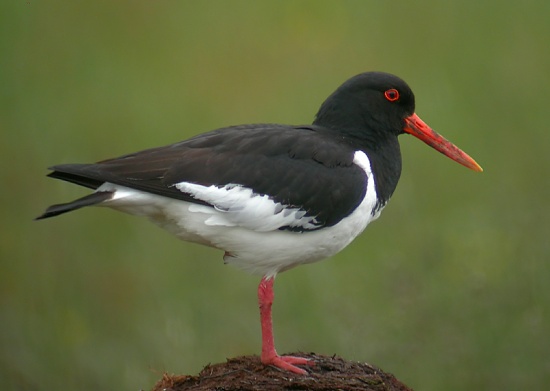(OBI link removed) |
|||
| Line 1: | Line 1: | ||
| − | |||
[[Image:Eurasian_Oystercatcher.jpg|thumb|550px|right|Photo by {{user|jenygard|jenygard}}]] | [[Image:Eurasian_Oystercatcher.jpg|thumb|550px|right|Photo by {{user|jenygard|jenygard}}]] | ||
;[[:Category:Haematopus|Haematopus]] ostralegus | ;[[:Category:Haematopus|Haematopus]] ostralegus | ||
==Identification== | ==Identification== | ||
| + | *Black above | ||
| + | *White below | ||
| + | *White wing and tail patches | ||
| + | *Red legs | ||
| + | *Strong broad red bill | ||
| + | *Juvenile - brown with white neck band and dull bill. | ||
==Distribution== | ==Distribution== | ||
[[Eurasia]]. Rare migrant on [[Greenland]]. Accidental vagrant to [[Newfoundland]] (several records). | [[Eurasia]]. Rare migrant on [[Greenland]]. Accidental vagrant to [[Newfoundland]] (several records). | ||
==Taxonomy== | ==Taxonomy== | ||
| − | ====Subspecies | + | ====Subspecies==== |
*''H. o. ostralegus'' - [[Iceland]] and [[Scandinavia]] to south [[Europe]]; winters to [[Africa]] | *''H. o. ostralegus'' - [[Iceland]] and [[Scandinavia]] to south [[Europe]]; winters to [[Africa]] | ||
*''H. o. longipes'' - [[Russia]] to [[Siberia]] and south to Caspian Sea and Aral Sea | *''H. o. longipes'' - [[Russia]] to [[Siberia]] and south to Caspian Sea and Aral Sea | ||
| Line 15: | Line 20: | ||
Beaches and coast in winter. Breeds in upload grassy areas. | Beaches and coast in winter. Breeds in upload grassy areas. | ||
==Behaviour== | ==Behaviour== | ||
| + | The diet includes molluscs, mussels and earthworms. | ||
| + | |||
| + | They nest in a scrape on pebbles or the coast; 2-4 eggs are laid. | ||
====Vocalisation==== | ====Vocalisation==== | ||
<flashmp3>Haematopus ostralegus (song).mp3</flashmp3><br /> | <flashmp3>Haematopus ostralegus (song).mp3</flashmp3><br /> | ||
''[[Media:Haematopus ostralegus (song).mp3|Listen in an external program]]'' | ''[[Media:Haematopus ostralegus (song).mp3|Listen in an external program]]'' | ||
| + | ==References== | ||
| + | Wikipedia | ||
==External Links== | ==External Links== | ||
{{GSearch|Haematopus+ostralegus}} | {{GSearch|Haematopus+ostralegus}} | ||
Revision as of 16:32, 30 March 2009

Photo by jenygard
- Haematopus ostralegus
Identification
- Black above
- White below
- White wing and tail patches
- Red legs
- Strong broad red bill
- Juvenile - brown with white neck band and dull bill.
Distribution
Eurasia. Rare migrant on Greenland. Accidental vagrant to Newfoundland (several records).
Taxonomy
Subspecies
- H. o. ostralegus - Iceland and Scandinavia to south Europe; winters to Africa
- H. o. longipes - Russia to Siberia and south to Caspian Sea and Aral Sea
- H. o. osculans - Kamchatka Peninsula and North Korea; winters east China
Habitat
Beaches and coast in winter. Breeds in upload grassy areas.
Behaviour
The diet includes molluscs, mussels and earthworms.
They nest in a scrape on pebbles or the coast; 2-4 eggs are laid.
Vocalisation
<flashmp3>Haematopus ostralegus (song).mp3</flashmp3>
Listen in an external program
References
Wikipedia
External Links



